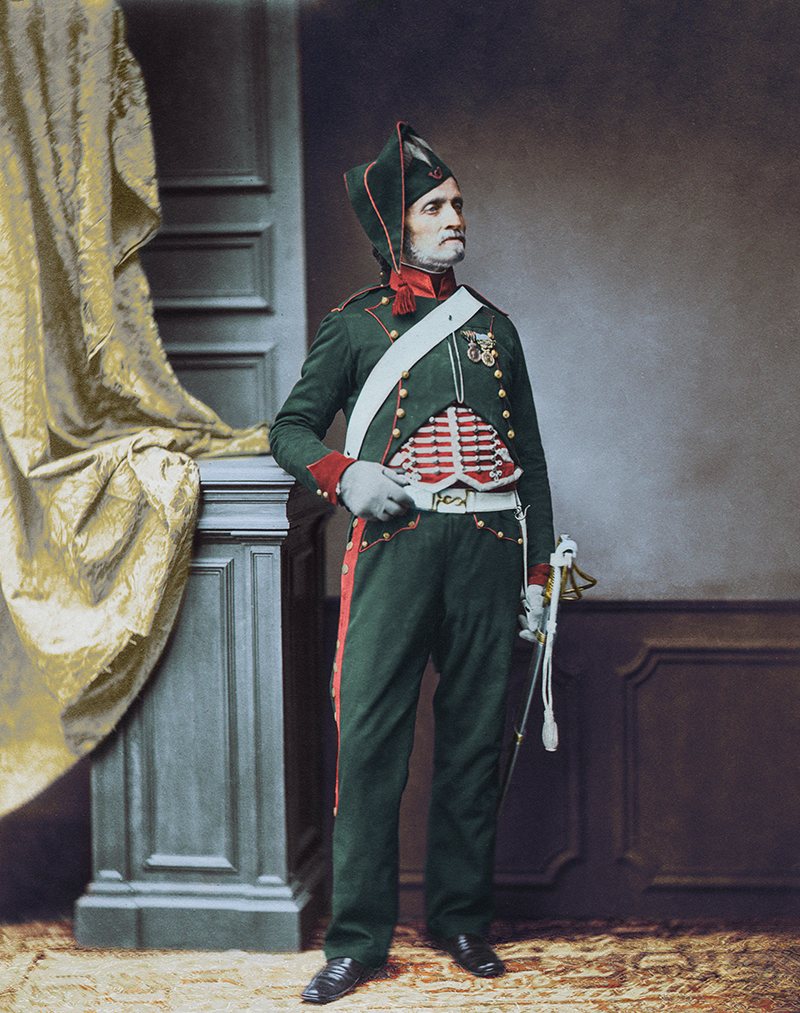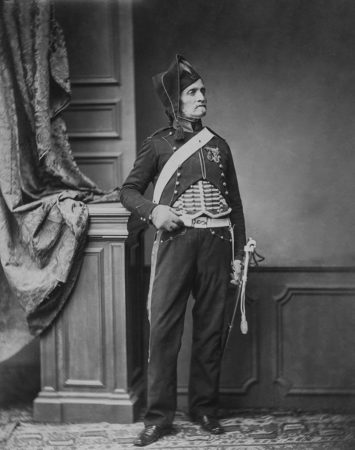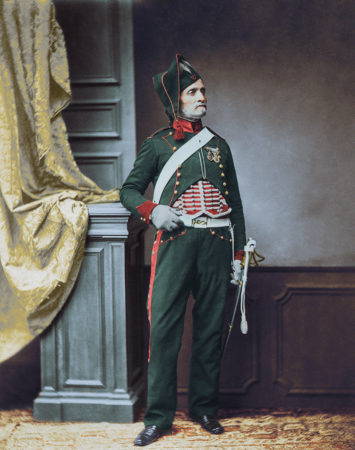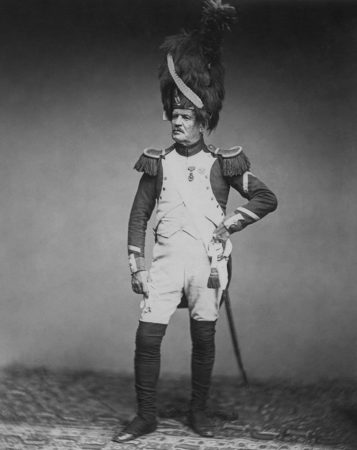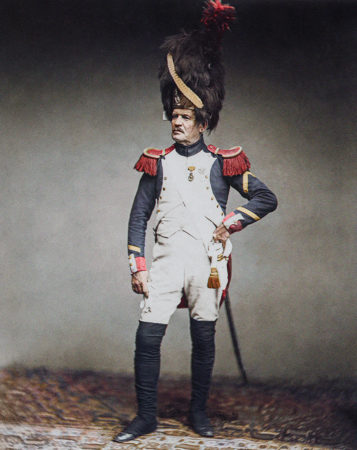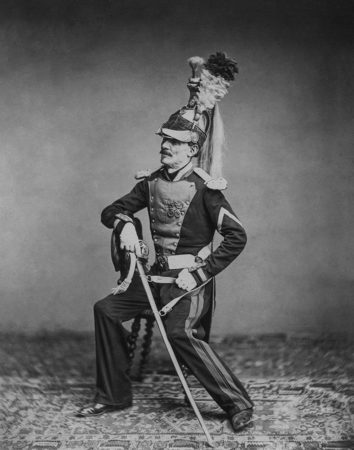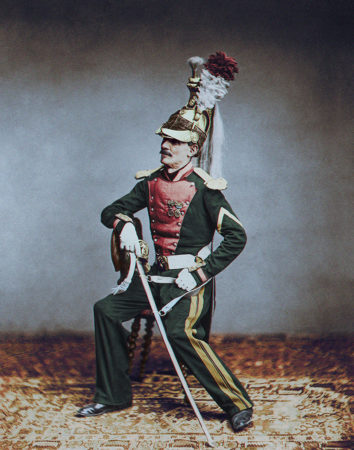The modernity of the Napoleonic Wars can sometimes be surprising, but it was in the aftermath of Napoleon’s rise and fall, crowned by his defeat at Waterloo in 1815, that the modern world began to take shape.
Artist Marina Amaral, who collaborated with Dan Jones on new book The Colour of Time: A New History of the World, 1850-1960, stumbled upon a treasure – a collection of photographs of Napoleon’s innovative Grand Armée veterans. These elderly, surviving soldiers had gathered together again in 1858 during an annual parade, and had their picture taken. Their uniforms had been re-tailored to suit their advanced age, but the glories of the past still lit up their eyes. These photographic mementos of Napoleon’s men became some of the earliest veteran photos ever captured. With modern technology, Amaral was able to bring Napoleon’s veterans to life by colourising their sepia images.
Amaral explained the background to the images on her blog, which provides details of their uniforms and the old warhorses who wore them.
Read on for more, as well as an interview with Marina herself.

When were these photos of the Grand Armee taken and what was the occasion for the photo shoot?
When and why these men were photographed is a mystery, but some clues are offered in Henri Bouchot’s book L’Epopée du Costume Militaire Français published in Paris in 1898, and containing pictures by the famous French military illustrator, Job.
There is a colour plate with a transparent overlay bearing the title ‘Les Vieux de la Vieille, Le 5 Mai, 1855’. This depicts ten Napoleonic veterans in their full uniforms passing the column in the centre of the Place Vendôme, which was erected by Napoleon to commemorate the battle of Austerlitz.
A Second Empire Zouave of the current French army looks at the hunched and slow-moving procession. Most significant is the fact that two of the veterans are carrying wreaths. If one compares the individuals in the photographs, they match up very well with the figures crossing the square.
The date of the event – May 5, – provides the reason why these men were in Paris, for that was the anniversary of the death of Napoleon and every year on that date veterans gathered in the capital, as the Times of London in May 1855 noted:
‘The base and railings of the column of the Place Vendôme appear this day decked out with the annual offerings to the memory of the man whose statue adorns the summit. The display of garlands of immortelles, and other tributes of the kind, is greater than usual…the old soldiers of the Empire performed their usual homage yesterday at the same place.’
On the same day, a funeral service was held in the chapel of the Invalides attended by Prince Jerome and other dignitaries. The entire personnel of the Invalides, as well as soldiers of the First Empire, were present.
A more likely date however, is May 5, 1858, because all the veterans are wearing the Saint Helene medal, which had been issued on August 12, 1857, to all veterans of the wars of the Revolution and the Empire.
Monsieur Schmidt of the Second Mounted Chausseur Regiment, who served in 1813-1814.
How did you go about accurately colour-matching the uniforms, and did you face any challenges?
It was a huge challenge to be able to reconstruct the original colours of all the pictures in the series.
There are several versions on the internet, but they all reproduce the wrong colours. I needed to get in touch with experts and enthusiasts to ensure that I made accurate choices.
Each photo was analysed individually by five different people, and I’m very pleased with the result.
Did you discover any interesting stories about the veterans in the course of researching them?
The fact that we know their names is fantastic. It’s amazing to think of everything these men saw and lived. They saw Napoleon with their own eyes!
Sargeant Taria strikes a proud pose
What motivates you to colourise archive photos and what do you think doing it reveals about the images?
When I see a photo in colour, I instantly feel more connected to what I am seeing. It’s almost like crossing a bridge between the present and the past.
My purpose is to offer people the possibility of seeing these scenes through the photographer’s eyes, as they saw them – in colour.
What can we expect from The Colour of Time, and what was it like working with Dan Jones on it?
The Colour of Time is a book that will cover the birth of modern world from the 1850s to 1960s, using 200 exclusive photos restored and colorised by me, plus Dan’s exciting narrative to tell this story, anchoring each image in a chronological context. It’s a huge book (448 pages), full of intriguing, interesting and important information presented in a way that anyone can understand. We have done our best to talk about a wide variety of countries, and I am really proud of the result. Dan is a fantastic author, a respected historian, and has become a dear friend. We can’t wait to see what people will think!
Monsieur Mauban, in full regalia of the 8th Dragoon Regiment (1815), takes a seat
Marina Amaral is a digital colourist based in Brazil. She combines her passion for history and Adobe Photoshop, to bring the past to life in glorious colour. She colourises images, from simple portraits to complex and multifaceted photographs. Her most recent book is The Colour of Time: A New History of the World, 1850-1960, co-produced with historian Dan Jones. For more information on Napoleon and his men, pick up a copy of our 64th issue, or subscribe to All About History for as little as £13.
